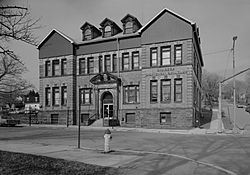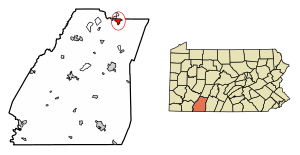Windber, Pennsylvania facts for kids
Quick facts for kids
Windber, Pennsylvania
|
|
|---|---|
|
Borough
|
|

Municipal building
|
|

Location of Windber in Somerset County, Pennsylvania.
|
|
| Country | United States |
| State | Pennsylvania |
| County | Somerset |
| Settled | 1897 |
| Incorporated | July 3, 1900 |
| Government | |
| • Type | Borough Council |
| Area | |
| • Total | 1.98 sq mi (5.12 km2) |
| • Land | 1.98 sq mi (5.12 km2) |
| • Water | 0.00 sq mi (0.00 km2) |
| Population
(2020)
|
|
| • Total | 3,930 |
| • Estimate
(2021)
|
3,893 |
| • Density | 1,929.22/sq mi (745.01/km2) |
| Time zone | UTC-5 (Eastern (EST)) |
| • Summer (DST) | UTC-4 (EDT) |
| Zip code |
15963
|
| Area code(s) | 814 |
| FIPS code | 42-85632 |
| Website | Windber Borough |
Windber is a small town, called a borough, in Somerset County, Pennsylvania, United States. It is about 3 miles (4.8 km) south of Johnstown. In 2020, about 3,930 people lived there. Windber was once a busy manufacturing town. Today, it is part of the larger Johnstown area.
Contents
History of Windber
Windber was started in 1897 as a special kind of town called a company town. This means a company built and owned most of the town, usually for its workers. Windber was built for the coal miners who worked in the nearby mines.
How Windber Got Its Name
The town was created by two powerful coal owners, Charles and Edward Julius Berwind. They owned the Berwind Corporation. The name "Windber" is simply the family name "Berwind" spelled backward.
Coal Mining and Workers
The Berwind-White Coal Mining Company brought many workers to Windber. These workers came from countries in eastern and southern Europe. The company also used differences between these new workers and the older German and Irish settlers.
The Coal Strike of 1922
In 1922, coal miners in Windber and nearby areas went on strike. A strike is when workers stop working to demand better conditions. The miners wanted their union, the United Mine Workers, to be officially recognized. They also wanted the company to weigh the coal they mined fairly. This was important because they were paid by how much coal they dug.
The mining company tried to stop the strike using legal actions and by hiring new workers. But the striking miners received a lot of support from people across the country and in their local community. They continued their strike for many months.
Later, in 1933, the United Mine Workers union successfully organized the mines. This happened after the Great Depression and the election of President Franklin Delano Roosevelt.
Windber's Historic Places
The Windber Historic District was added to the National Register of Historic Places in 1991. This means it's an important place with a rich history.
The Trolley Graveyard
Windber is also home to the Vintage Electric Streetcar Company. People often call it the "trolley graveyard." This private yard has many old PCC streetcars and other public transport vehicles. These vehicles are sometimes sold to be used again or taken apart for spare parts.
Geography of Windber
Windber is located at 40°14′7″N 78°49′51″W / 40.23528°N 78.83083°W. The town covers an area of about 2.1 square miles (5.4 square kilometers). All of this area is land.
Population and People
| Historical population | |||
|---|---|---|---|
| Census | Pop. | %± | |
| 1910 | 8,013 | — | |
| 1920 | 9,462 | 18.1% | |
| 1930 | 9,205 | −2.7% | |
| 1940 | 9,057 | −1.6% | |
| 1950 | 8,010 | −11.6% | |
| 1960 | 6,994 | −12.7% | |
| 1970 | 6,332 | −9.5% | |
| 1980 | 5,585 | −11.8% | |
| 1990 | 4,756 | −14.8% | |
| 2000 | 4,395 | −7.6% | |
| 2010 | 4,138 | −5.8% | |
| 2020 | 3,930 | −5.0% | |
| 2021 (est.) | 3,893 | −5.9% | |
| Sources: | |||
In 2000, there were 4,395 people living in Windber. Most of the people living in the borough were White. A small number of people were from other racial backgrounds. About 0.57% of the population was Hispanic or Latino.
The average age of people in Windber in 2000 was 43 years old. About 21.3% of the population was under 18 years old. About 24.6% of the population was 65 years or older.
Education in Windber
Students in Windber attend schools that are part of the Windber Area School District.
Fun Things to Do
The Silver Drive-In movie theater is located near Windber. It first opened in 1962. Many other drive-in theaters have closed over the years, but the Silver Drive-In is still open. It is the only drive-in theater in the Johnstown area.
Notable People from Windber
Many interesting people have come from Windber, including:
- Jim Bonfanti, a drummer for the band the Raspberries
- Bill Elko, a professional football player
- Alan Freed, a radio disc jockey who helped make the term "Rock and Roll" popular
- Dave Geisel, a retired Major League Baseball (MLB) player
- Mark A. Heckler, a former President of Valparaiso University
- Gene Heeter, a professional football player
- Rebekah Jones, a geographer and data scientist
- Frank Kostro, a retired MLB player
- Frank Kush, a famous football coach
- Johnny Weissmuller, an Olympic swimmer and Hollywood movie star
- J. Irving Whalley, a United States congressman
See also
 In Spanish: Windber para niños
In Spanish: Windber para niños


